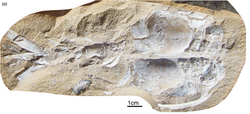Biology:Montecaris
| Montecaris | |
|---|---|

| |
| Montecaris gogoensis | |
| Scientific classification | |
| Kingdom: | |
| Phylum: | |
| Subphylum: | |
| Class: | |
| Subclass: | |
| Order: | Archaeostraca
|
| Suborder: | Ceratiocaridina
|
| Family: | Echinocarididae
|
| Genus: | Montecaris Ulrich Jux, 1959
|
| Type species | |
| Montecaris strunensis Jux, 1959
| |
Montecaris is a genus of extinct phyllocarid crustaceans found in the Upper Devonian of Europe,[1][2][3][4][5] Canada ,[6] and Australia.[7]
Description
Montecaris possesses an unornamented, bivalved carapace which terminates in a spiny posterior. Its caudal tail fin is trifurcated and dagger-like. Species of Montecaris from Europe and Canada are no more than 15 cm (5.9 in) in length, while M. gogoensis from the Gogo Formation of Australia can reach lengths of 24 cm (9.4 in) and, rarely, up to 60 cm (2.0 ft).[6][7]
Due to its streamlined carapace and large tail fin, Montecaris was likely an active nektonic swimmer, which primarily appears in deep water sediments. Its robust mandibles and powerful musculature suggests a carnivorous lifestyle as an active predator or scavenger.[7]
Species
- M. antecedens Chlupač, 1960[3]
- M. brunnensis Chlupač, 1960[3]
- M. gogoensis Briggs, 2011[7]
- M. lehmanni Jux, 1960[2] (Possibly synonymous with M. strunensis)[7]
- M. strunensis Jux, 1959[1]
- M. tatarica Krestovnikov, 1961[4]
References
Note: This topic belongs to "Crustaceans" portal
- ↑ 1.0 1.1 Jux, Ulrich (July 1959). "Phyllocariden-Reste aus dem oberen Mitteldevon der Bergisch Gladbach-Paffrather Mulde". Paläontologische Zeitschrift 33 (3): 166–171. doi:10.1007/bf02987374. ISSN 0031-0220. http://dx.doi.org/10.1007/bf02987374.
- ↑ 2.0 2.1 Jux, U. (1960). "Montecaris lehmanni, a new crustacean from the Rhenish Devonian and the problem of its systematic position". Journal of Paleontology (34): 1129–1152.
- ↑ 3.0 3.1 3.2 Chlupač, I. (1960). "Die Gattung Montecaris Jux (Crustacea, Phyllocarida) im alteren Pal ¨ aozoikum der Tschechoslowakei". Geologie (9): 638–649.
- ↑ 4.0 4.1 V.N., Krestovnikov (1961). "Novyye rakoobraznye fillokaridy Paleozoya Russkoi platformy, Urala, Timana i Donbassa [New phyllocarid crustaceans from Palaeozoic of the Russian plateau, the Urals, Timan and the Donetz Basin]". Trudy Geologicheskogo Instituta (52): 1–67.
- ↑ Zatoń, Michał; Filipiak, Paweł; Rakociński, Michał; Krawczyński, Wojciech (2014). "Kowala Lagerstätte: Late Devonian arthropods and non-biomineralized algae from Poland" (in en). Lethaia 47 (3): 352–364. doi:10.1111/let.12062. ISSN 0024-1164. https://www.idunn.no/doi/10.1111/let.12062.
- ↑ 6.0 6.1 Pratt, Brian R. (1987-06-01). "The phyllocarid crustacean Montecaris from the Devonian of northwestern Canada". Canadian Journal of Earth Sciences 24 (6): 1267–1269. doi:10.1139/e87-121. ISSN 0008-4077. http://dx.doi.org/10.1139/e87-121.
- ↑ 7.0 7.1 7.2 7.3 7.4 Briggs, Derek E. G.; Rolfe, W. D. Ian; Butler, Piers D.; Liston, Jeff J.; Ingham, J. Keith (2011). "Phyllocarid crustaceans from the Upper Devonian Gogo Formation, Western Australia" (in en). Journal of Systematic Palaeontology 9 (3): 399–424. doi:10.1080/14772019.2010.493050. ISSN 1477-2019. http://www.tandfonline.com/doi/abs/10.1080/14772019.2010.493050.
Wikidata ☰ Q23928262 entry
 |

